Palmer Station Timeline
1985-95
Summer 1985-86
The BAS vessel John Biscoe was beset near Adelaide Island (13 November); after the trapped ship started drifting towards icebergs, Polar Duke was called to help. It could not free the British ship, and 64 passengers were taken to Palmer Station. Later Polarstern was able to free John Biscoe, which then returned to Palmer to pick up the personnel there.
Four-year Washington State air chemistry (clean air) project ends (December)
Construction completed on boathouse and aquarium buildings
Winter 1986
Manager: Gary Heimark; population 7 (list and photo)
Additional laboratory space constructed.
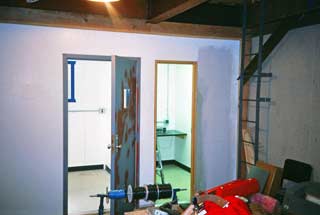 Most of the ground floor space except for the original labs was devoted to machine shop and storage space to support the R/V Hero, which would spend most of the summer seasons at Palmer. With its replacement, some of this space was converted for science uses. These were labs 7 and 8, opening into the hoist room, they were being finished up when I showed up in October 1986. The actual lab numbering system was developed this summer and incorporated into the 1987 "Your Stay at Palmer Station" brochure (to be scanned someday). Here's another photo looking down the hallway, lab 6 is behind that electrical panel; lab 9 with the autoclaves is behind the wall at left. These labs would be replaced during the 2002 lab renovations.
Most of the ground floor space except for the original labs was devoted to machine shop and storage space to support the R/V Hero, which would spend most of the summer seasons at Palmer. With its replacement, some of this space was converted for science uses. These were labs 7 and 8, opening into the hoist room, they were being finished up when I showed up in October 1986. The actual lab numbering system was developed this summer and incorporated into the 1987 "Your Stay at Palmer Station" brochure (to be scanned someday). Here's another photo looking down the hallway, lab 6 is behind that electrical panel; lab 9 with the autoclaves is behind the wall at left. These labs would be replaced during the 2002 lab renovations.
Summer 1986-87
Coast Guard icebreaker Glacier completes final year of Antarctic service with science cruises and calls at Palmer Station and McMurdo--Glacier when new participated in IGY. She was decommissioned in July 1987.
Carpenter shop expanded.
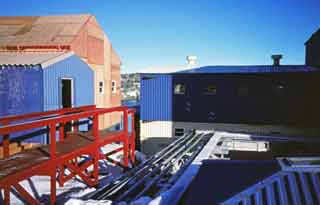 This is what the addition looked like when I showed up at the end of the summer--in this view the roof of the sauna is in the right foreground. Not the first addition to this structure, nor the last. And I was not involved in its design or approvals--that was Richie Skane's doing.
This is what the addition looked like when I showed up at the end of the summer--in this view the roof of the sauna is in the right foreground. Not the first addition to this structure, nor the last. And I was not involved in its design or approvals--that was Richie Skane's doing.For comparison, here's a "before" view, from a top floor Biolab window, of what the building looked like at the beginning of the summer--not to mention the backyard and the glacier. And here's a view from another angle, documenting the earlier addition as well as preparations for further expansion.
Winter 1987
Manager: Rich Dunning; population 6 (list and photo)
Summer 1987-88
A huge construction contingent was on station.
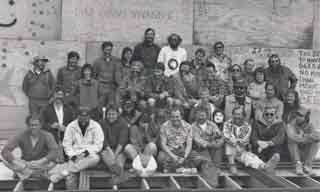
I'm thinking this photo was taken on an unfinished deck of the carp shop...alas, I don't know who originally shared this picture on Facebook in 2013. Click on the photo for the full caption.
Winter 1988
Manager: Tom Brutscher; population 9 (list and photos)
UV monitor (Biospherical Instruments) originally installed in roof of Clean Air vestibule
Original 150 KW generators (342's) replaced with new 250 KW 3406's
Summer 1988-89
An early 1988-89 summer group photo from Dave Gallas.
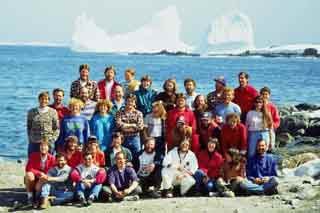
Another large crew as much construction as well as science was happening.
Argentine Navy vessel Bahia Paraiso, captained by Juan Carlos Sampietro, hits a rock 2 miles from Palmer Station and runs aground (28 January)...
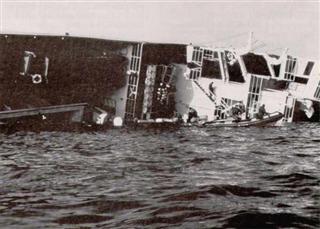 When the 430-foot vessel initially ran aground, a 30' gash was torn in the hull below the waterline. All power was soon lost, the ship rapidly listed, and the rescue efforts proceeded. Along with 300+ crew and tourists (who ended up at Palmer Station), the vessel carried an estimated 250,000 gallons of petroleum products which immediately started to become evident on the surface of Arthur Harbor. Several days later the vessel floated free and drifted closer to Palmer Station before running aground near DeLaca Island and capsizing as shown in the picture at right. I wasn't at Palmer when this happened, but many friends were...including 1989 w/o Dave Gallas who published his amazingly detailed story of the event (link updated 30 July 2006)! (NSF photo by Ted DeLaca, Antarctic Journal 6/89)
When the 430-foot vessel initially ran aground, a 30' gash was torn in the hull below the waterline. All power was soon lost, the ship rapidly listed, and the rescue efforts proceeded. Along with 300+ crew and tourists (who ended up at Palmer Station), the vessel carried an estimated 250,000 gallons of petroleum products which immediately started to become evident on the surface of Arthur Harbor. Several days later the vessel floated free and drifted closer to Palmer Station before running aground near DeLaca Island and capsizing as shown in the picture at right. I wasn't at Palmer when this happened, but many friends were...including 1989 w/o Dave Gallas who published his amazingly detailed story of the event (link updated 30 July 2006)! (NSF photo by Ted DeLaca, Antarctic Journal 6/89)Winter 1989
Manager, Tom Brutscher; Population 7-10 (list and photos).
WINCRUISE III is documented on one of its several stops at Palmer.
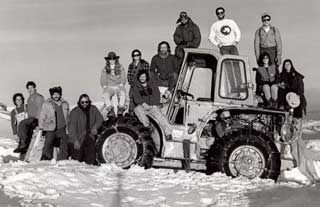
The WINCRUISE series eventually comprised six winter cruises of the Southern Ocean and the Palmer Station area. The first of these was in 1985--taking advantage of the larger and much more powerful new research vessel Polar Duke as compared to the Hero. They would continue every two years through 1993, with the final one during the 1994 winter. These cruises combined oceanographic research and at-sea collecting with lab work at Palmer. Somehow during the winter 1989 a group of winterovers and cruise members gathered for this unusual photo around the ancient (and soon-to-be-replaced) Athey loader/forklift. More info...
T-5 upgraded to house satellite imaging system (Seaspace/Terascan), first data received (August).
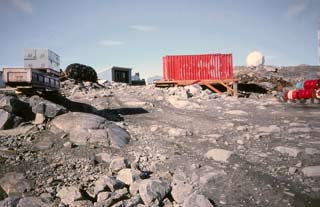 With some difficulty I (in the Paramus office) was able to obtain the radome bolt template so that Richie Skane (who was on site) could get the foundation poured so the radome and antenna could be assembled. It was amazing to walk into the back of T-5 and see images of ice coverage... which of course were quite important to the research vessels operating around the Peninsula. This photo of mine is from March 1990 looking uphill from in front of GWR; T-5 is just to the left of the milvans. I don't have a closeup photo of the radome, but here's a July 2018 photo of the current smaller antenna from Steve Allerding (the w/o physician) as well as a June 2004 photo from Seth White. Both photos show the (presumably) original bolts.
With some difficulty I (in the Paramus office) was able to obtain the radome bolt template so that Richie Skane (who was on site) could get the foundation poured so the radome and antenna could be assembled. It was amazing to walk into the back of T-5 and see images of ice coverage... which of course were quite important to the research vessels operating around the Peninsula. This photo of mine is from March 1990 looking uphill from in front of GWR; T-5 is just to the left of the milvans. I don't have a closeup photo of the radome, but here's a July 2018 photo of the current smaller antenna from Steve Allerding (the w/o physician) as well as a June 2004 photo from Seth White. Both photos show the (presumably) original bolts.Summer 1989-90
NSF sends a preliminary site investigation to Stonington Island, site of East Base (US Antarctic Service Expedition 1939-41 and Ronne's 1947-48 expedition) (March/April); the first such visit since 1976 (yes, I was along, photos coming soon). This was the first of three NSF ventures to the base, all supported by the French workboat Erebus.
Biolab siding panels, windows and doors replaced.
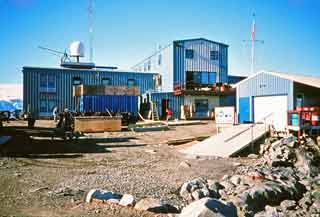
Here's my look at the biolab in April after the work was about 90% complete. The original building panels were the same as had been used on a number of buildings at McMurdo constructed in the same 1960s time frame, but the warmer moist climate at Palmer caused a more rapid deterioration (more information and photos).
SteelPotable water tank (in the biolab machine shop) replaced.
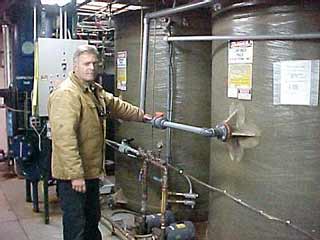 It was replaced with two vertical food-grade plastic tanks. The old tank had an epoxy lining which had deteriorated and was starting to rust. It had one incredibly small manway, so I refused any thoughts of repairing the coating. The project was delayed until this season so the new tanks could be brought into the building through the wall while replacing the siding panels. The work was scheduled while the fresh water pond in the backyard could provide plenty of water; one of the tanks was set up for temporary use in the middle of the room while the old tank was cut up and the piping was reworked. This January 2000 photo shows Norm Lavoie in front of the tanks; it is by teacher Mimi Wallace who was on station as part of the TEA project); her blog post is here.
It was replaced with two vertical food-grade plastic tanks. The old tank had an epoxy lining which had deteriorated and was starting to rust. It had one incredibly small manway, so I refused any thoughts of repairing the coating. The project was delayed until this season so the new tanks could be brought into the building through the wall while replacing the siding panels. The work was scheduled while the fresh water pond in the backyard could provide plenty of water; one of the tanks was set up for temporary use in the middle of the room while the old tank was cut up and the piping was reworked. This January 2000 photo shows Norm Lavoie in front of the tanks; it is by teacher Mimi Wallace who was on station as part of the TEA project); her blog post is here.Skytrak telehandler forklift makes its appearance.
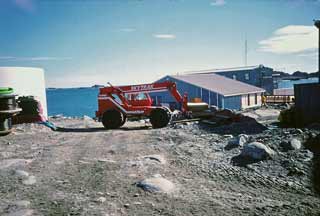 Until this season the forklift was ATHEY--an old military rough terrain forklift, from Athey Products Corporation, then of Chicago (pictured here surrounded by winterovers and members of WINCRUISE III during the 1989 winter). ATHEY had low mileage for obvious reasons, but it was overly complex for the station needs. The biggest problem was that parts were only available through the military procurement system, in which it was obsolete. So I was asked to come up with something modern and versatile... with the ability to reach into milvans. This was the result. It got delivered in March on the Polar Duke...and later another was procured--this model is still available. I don't think the term "telehandler" existed at the time. It was retrograded in October 2019.
Until this season the forklift was ATHEY--an old military rough terrain forklift, from Athey Products Corporation, then of Chicago (pictured here surrounded by winterovers and members of WINCRUISE III during the 1989 winter). ATHEY had low mileage for obvious reasons, but it was overly complex for the station needs. The biggest problem was that parts were only available through the military procurement system, in which it was obsolete. So I was asked to come up with something modern and versatile... with the ability to reach into milvans. This was the result. It got delivered in March on the Polar Duke...and later another was procured--this model is still available. I don't think the term "telehandler" existed at the time. It was retrograded in October 2019.Winter 1990
Manager: Andy Deering; population 11-12 (list and photo).
"Rec hut" constructed in the backyard overlooking Arthur Harbor.
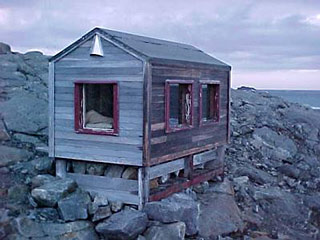
This was a Richie Skane project, but I never knew it was going to happen although I was at Palmer in April. Thumper (James Porter) is an amazing guy--I met him at Siple Station in January 1988, but his first ice season was there in 1976-77 with Pete Harding. He would later winter at Pole in 1994. As for this venerable structure, here is documentation of its original construction. it was rebuilt above the foundation in 2009-10. Oh by the way, Thumper eventually went to law school and became an attorney.
Summer 1990-91
Unusual aircraft incident (19 October)--a Kenn Borek flight from Marsh Base to Rothera (perhaps en route to Pole/McM?) was to drop mail on a fly-by. But...when the mailbag was dropped, it was sucked through the starboard propeller, damaging two of the three blades and prompting an emergency landing. After calls to Calgary, they cut four inches off each blade to reduce vibration so they could reduce vibration and fly out without waiting for a new prop. The mail...most of what was damaged was philatelic (thanks to Dave Gallas for this tale!).
Old Palmer building removed, debris from US and British occupation cleaned up.
Second NSF trip made to Stonington Island, this one, to plan the future conservation efforts, included two National Park Service (NPS) preservation experts, Cathy and Robert Spude. Here is their report, extracted from the NPS publication Cultural Resource Management (Vol. 15, No. 2, 1992).
Winter 1991
Manager: Fred Fredricks; population 10-11 (list and photos).
Platform built on roof of T-5 for all-sky camera.
Summer 1991-92
Bonaparte Point AWS installed (December)
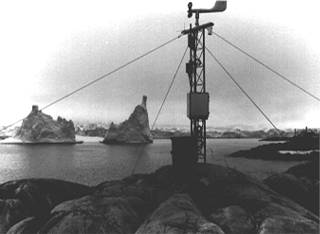
Here's a 1995 photo from the AWS group at the University of Wisconsin (UW) in Madison. This unit, as well as the ones later installed at Hugo Island and RACER Rocks, are regularly monitored on station using the Terascan system. Here's the 1999 UW photo.
Mark Eichenberger (age 38) swept into the sea and lost (21 December)
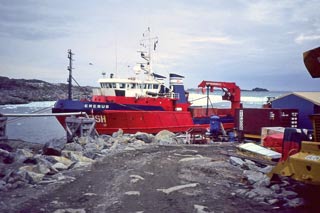 Mark was working aboard the USAP-chartered French workboat Erebus (left, a photo of Erebus at Palmer from Dave Gallas) (my March 1990 photo) as it was tied up to the pier in Punta Arenas, shortly after arriving from Palmer Station. When a storm struck, he was attempting to cast off so they could leave the dock, but he lost his footing and was swept overboard, his body was never found. Mark had been the Palmer/Peninsula system manager for ITT/ANS in the mid 80's and also a Hero relief captain; he'd moved on by the time I showed up, but many people I knew had worked with him. In 1988 Mark and three companions--Ned Gillette, Fred Trombly, and Polie friend Jay Morrison had been the first to row from South America to Antarctica.
Mark was working aboard the USAP-chartered French workboat Erebus (left, a photo of Erebus at Palmer from Dave Gallas) (my March 1990 photo) as it was tied up to the pier in Punta Arenas, shortly after arriving from Palmer Station. When a storm struck, he was attempting to cast off so they could leave the dock, but he lost his footing and was swept overboard, his body was never found. Mark had been the Palmer/Peninsula system manager for ITT/ANS in the mid 80's and also a Hero relief captain; he'd moved on by the time I showed up, but many people I knew had worked with him. In 1988 Mark and three companions--Ned Gillette, Fred Trombly, and Polie friend Jay Morrison had been the first to row from South America to Antarctica.
East Base visited, conserved, and documented by NSF archaeological team.
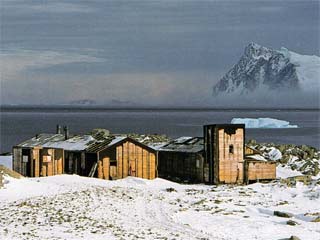
The base on Stonington Island (south of Palmer and Rothera in Marguerite Bay), was built by the US Antarctic Service Expedition in 1939-41, and later occupied by Finn Ronne's private expedition in 1947-48. In 1991-92 an eight-man team spent 2 weeks on site in February/March collecting artifacts, cleaning and stabilizing buildings, and removing hazardous materials. The group was led by archaeologist Noel Broadbent and included OAE Mark Melcon as well as writer Michael Parfit and photographer Robb Kendrick. They documented the trip in the March 1993 National Geographic (source of this photo and this National Archives photo of the original base construction). Displays and signage were erected for future visitors.
Winter 1992
Manager: Fred Frederick; population 10-11 (list and photos).
Summer 1992-93
UV monitor relocated to new addition constructed on side of T-5.
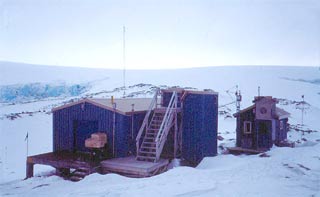
This view is from the front of the buildings; this 1996 photo is from the UCSD Keeling air sampling project. Here's another good view of the addition from the backyard side of the building.
Joint Argentina-Netherlands project removes the remaining accessible oil from the Bahia Paraiso.
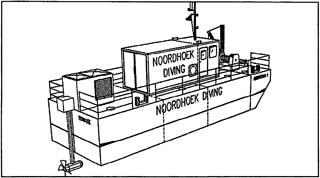 Argentina provided the vessel, while the Netherlands provided the equipment and staffing. The Netherlands awarded the contract to Noordhoek Diving, which provided two workboats (left) constructed from two 40' shipping containers, the center portions of which contained tanks. They also provided booms, skimmers, hot tap equipment, pumps, etc. Argentina provided the Canal Beagle, a naval transport. They arrived at Palmer on 3 December, and stayed until 4 January, removing about 31,000 gallons of diesel and 15,500 gallons of lube oil. Reference: Antarctic Vol. 12, No. 11 & 12., pp 400-401.
Argentina provided the vessel, while the Netherlands provided the equipment and staffing. The Netherlands awarded the contract to Noordhoek Diving, which provided two workboats (left) constructed from two 40' shipping containers, the center portions of which contained tanks. They also provided booms, skimmers, hot tap equipment, pumps, etc. Argentina provided the Canal Beagle, a naval transport. They arrived at Palmer on 3 December, and stayed until 4 January, removing about 31,000 gallons of diesel and 15,500 gallons of lube oil. Reference: Antarctic Vol. 12, No. 11 & 12., pp 400-401.
USGS personnel install first seismic equipment, on line 3 March, in new backyard vault.
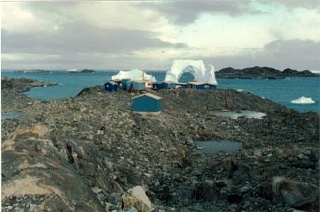
The back view looking toward the station and a couple of very interesting icebergs. Too bad the photo wasn't bigger... The 3 seismometers were mounted on an existing concrete pad (old antenna foundation) on bedrock, and the structure was built around it. The original instruments were under bell jars maintained at a vacuum--something that had to be checked periodically. Data is recorded in T-5 (and now sent north by satcom). About that iceberg... it collapsed shortly after this photo was taken, and the shock caused several of the Duke's mooring lines to part. This USGS/IRIS photo was taken during the original installation visit.
Winter 1993
Manager: Gerald Ness; population 8-16 (list and photos).
Summer 1993-94
Winter 1994
Manager: Kirk Kiyota; population 20-27 (list and photos).
Summer 1994-95
AWS installed near Hugo Island (initially named "Santa Claus").
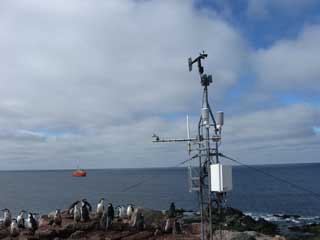
This was the second Antarctic Peninsula AWS installed as part of the LTER Network (the first had been installed on Bonaparte Point in December 1991). The original station was installed on a small islet near Hugo Island (64º57'S-65º45'W) during the University of Hawai'i at Mānoa Project SANTA CLAUS cruise aboard the R/V Polar Duke (hence the original "Santa Claus" name for the AWS). This Chief Scientist report describes the installation. The photo at left depicts the more recent 2009 Hugo AWS as it appeared in 2013; this University of Wisconsin AWS page provides more information and photos.
Winter 1995
Manager, Kirk Kiyota, population 25 (list and photo).
Continue to 1995-2005 timeline